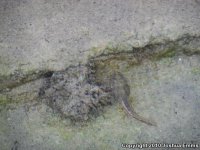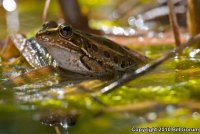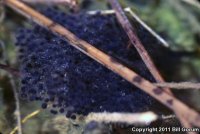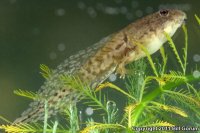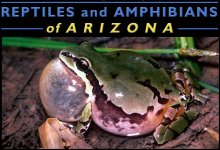| Range: |
 |
| Other Names: |
|
| Description: |
A moderate to large (up to about 4.5 inches in length) leopard frog. The dorsum typically has numerous dark spots and raised dorsolateral folds on a background of brown, grayish, bronze, green, or olive green, or a combination of these colors. Individuals occasionally lack spots. The ventral surface is cream-colored, sometimes with a dusky wash on the throat. This species is distinguished from other New Mexico leopard frogs by discontinuous dorsolateral folds that are inset towards the rear; a bold, dark reticulation on the rear of the thighs; prominent vocal sacs on adult breeding males; usually an absence of spots on the snout; and an incomplete light lip or supralabial stripe. Tadpoles are light-colored and mottled and may reach 3.75 inches total length.
|
| Similar Species: |
It can be distinguished from the Lowland Leopard Frog by its greater propensity for green coloration on the body, its highly contrasting reticulated thigh pattern and the presence of vestigal oviducts in males. Although the Plains Leopard Frog is the only other leopard frog that occurs in Eddy County, it has not been found sympatrically with L. berlandieri. |
| Habitat: |
Found in arid regions, often near brooks, creeks, or streams; L. berlandieri may also be near cattle irrigation tanks. |
| Behavior: |
Can be found active day or night, although they are much easier to find and observe at night with a headlamp or flashlight. They burrow to avoid the heat of the sun. |
| Hibernation: |
Active nearly year-round, this species hibernates on the bottom of ponds or ditches with slow-moving water on the coldest days of winter. |
| Reproduction: |
Breeding occurs probably from February into November, but is most common in the spring and early summer. Egg masses up to 3.5 inches across are deposited in quiet water. Some tadpoles overwinter. Males have a loud, rattling advertisement call that is audible for a quarter of a mile or more in some situations. |
| Diet: |
This species will eat a variety of invertebrate and vertebrate, aquatic and terrestrial prey. |
Adapted from account at 

